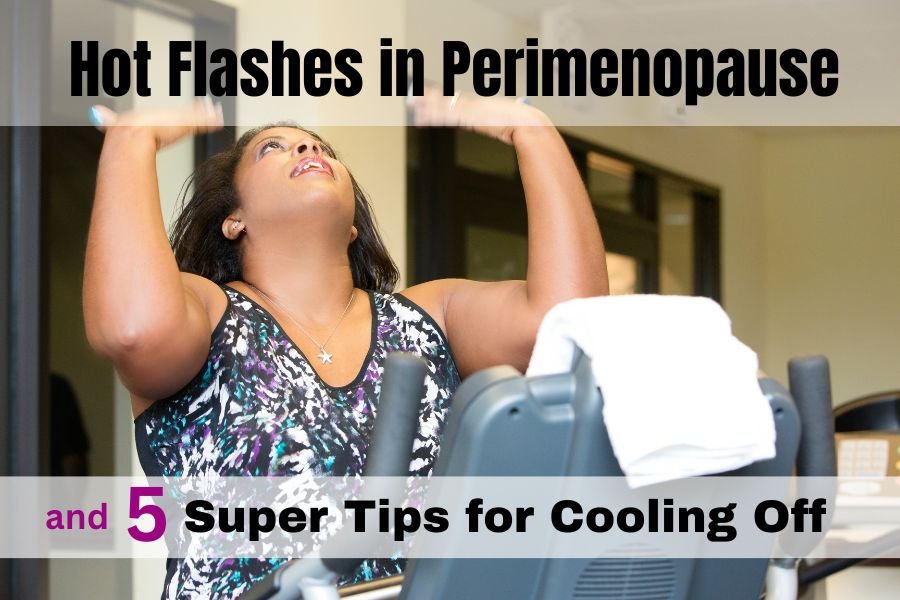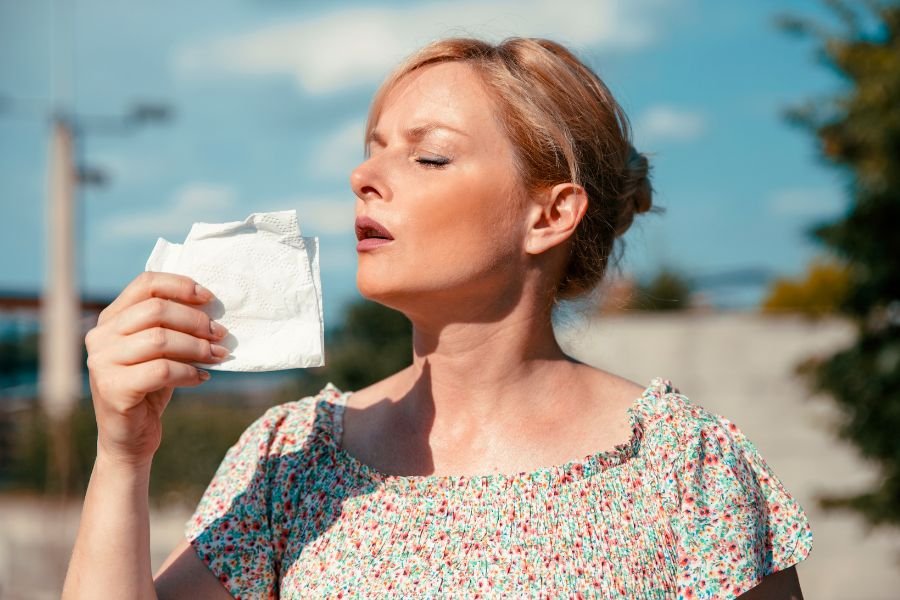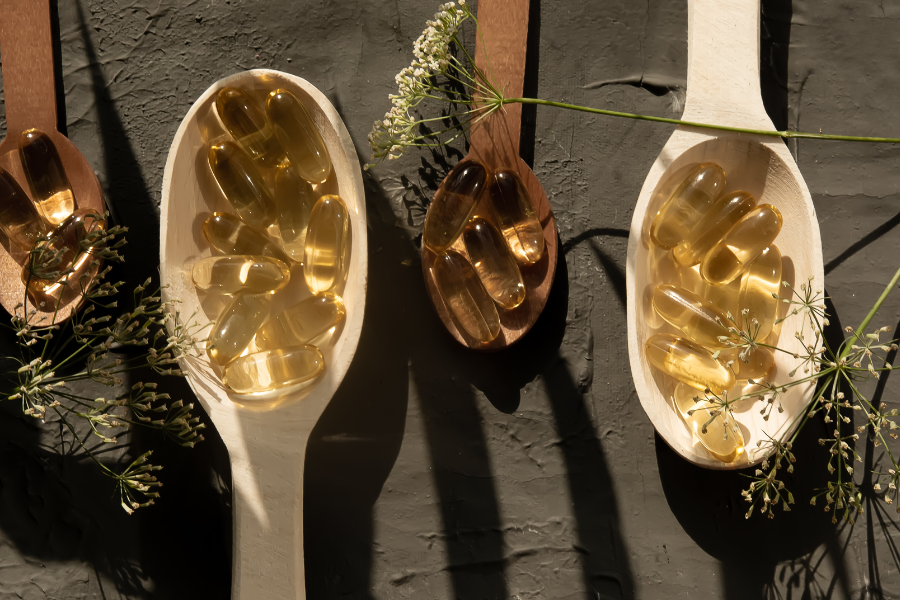Wondering what causes hot flashes in perimenopause? Check out this post to learn more and check out 5 super tips for cooling off!

What causes hot flashes in perimenopause? And 5 Super Tips for Cooling Off!
Navigating the tumultuous (and often warm) waves of perimenopause can feel like a journey into the unknown, especially when it comes to managing hot flashes in perimenopause. These sudden, intense bouts of warmth that seem to take over your body can be bewildering and uncomfortable- and greatly impact a woman’s life!
In this blog post, we’ll dive deep into the causes of hot flashes during this transitional phase and offer five super tips for cooling off. From understanding what triggers these heat surges to exploring both conventional and unconventional methods of relief, we’ve got you covered. So, let’s get started on this enlightening journey together.
This post contains affiliate links but I only recommend products I use myself and with my patients. Always discuss any supplements, medications, or products with your healthcare provider.
What are hot flashes?
Hot flashes are sudden feelings of warmth, often intense, that can spread throughout the body but are most commonly felt in the face, neck, and chest. All of these areas or just some of them can be affected.
They can lead to blushing or flushing and are sometimes accompanied by sweating.
These episodes can last from a few seconds to several minutes and may be followed by chills. Hot flashes are a hallmark symptom of perimenopause and menopause, signaling changes in the body’s hormone levels, particularly estrogen.
- Sudden warmth in face, neck, chest
- They may include sweating or chills
- Last from seconds to minutes
- Indicative of hormonal changes in perimenopause/menopause
Why do hot flashes happen in perimenopause?

Hot flashes during perimenopause are primarily due to fluctuations in hormone levels, particularly estrogen. As the ovaries gradually decrease estrogen production, the body’s temperature regulation gets disrupted.
This hormonal imbalance affects the brain’s hypothalamus, which is responsible for controlling body temperature. We primarily see hot flashes in late perimenopause, but they can show up in early perimenopause too.
When estrogen levels drop, the hypothalamus may mistakenly sense that the body is too hot. This triggers a hot flash, where blood vessels near the skin’s surface widen to cool off, causing the sudden warmth and sweating.
- Hormonal fluctuations, especially in estrogen
- Disruption in body’s temperature regulation
- Miscommunication in the hypothalamus
- Blood vessels near the skin’s surface widen
This struggle with hormones and body temperature control mechanisms underscores why hot flashes are a common and distinctive feature of perimenopause.
Night sweats can be a bit different and can be primarily related to drops in progesterone.
1. Keep Yourself Cool

Keeping yourself cool can come in many forms in perimenopause. We will dive into supplemental and treatment modalities but first let’s cover the basics.
Dressing in layers allows for quick adjustments based on your comfort level. Opt for natural fibers like cotton, which are breathable and help in managing body temperature.
Carrying a portable fan can offer you quick relief, particularly in the summer months. Another new device (pricey but interesting and effective) is called the Embr Wave Cooling and Warming Wrist Band. This device is worn on the wrist and provides pulsed cooling sensations at the touch of a button. The response and effectiveness generally improve over time, so if you don’t feel it right away don’t worry- it will get better.
- TAKE CONTROL OF HOT FLASHES* - Clinically proven to be a safe and effective solution for managing hot flashes, chills, night sweats, and disrupted sleep. Get precisely calibrated cooling or warming sensations at the touch of a button.. *Results typically improve over time. You may not feel the Wave’s full effectiveness at first. USE EMBR WAVE FOR AT LEAST TWO WEEKS to give your body time to adjust.
- PERSONALIZED RELIEF - Connect to the Embr Wave 2 app to unlock dozens of ways to benefit from your device. Explore expanded cooling and warming sessions, including categories like Focus, Temperature Tools, hot flashes, sleep, tension, and relaxation. Enjoy all-day and all-night relief tailored to your needs. Quickly soothe heat with Turbo Chill, unwind with Bear Hug mode, customize durations, reprogram device buttons, and track usage patterns for optimized comfort.
- SMART TECHNOLOGY - Powered by advanced thermal technology grounded in science. Get 9+ hours* of cooling or warming on a battery that fully charges in 2 hours. *Actual battery life will vary based on device settings and usage.
- COMFORTABLE, STYLISH, & DISCREET - Seamlessly integrates into your lifestyle and fashion. Unlike noisy fans, bulky vests, or messy ice packs, Embr Wave looks like jewelry or a smartwatch and operates totally silently. Get relief—anytime, anywhere—without disruptions or unwanted attention.
- WHAT'S IN THE BOX - Includes the Wave 2 with a stainless steel Milanese loop band with a magnetic clasp in a matching finish, magnetic charger with USB cable, and quick start guide. Fits wrists approximately 5.3-9.25” / 135-235mm mm in size
Cold water, or cooling wipes are another handy tool, providing a quick way to freshen up and lower your skin’s temperature. I love this brand, Womaness Here There Everywhere Menopause Wipes. They contain rosewater, aloe leaf extract, chamomile, and cranberry fruit, and are great for soothing and cooling at the gym, work, and on the go in general.
Essential Oils can also be helpful. Some of my favorite essential oils for cooling are clary sage, Peppermint Oil, and Lavender. See our full blog on the top essential oils for perimenopause.
In summary:
- Dress in layers for easy adjustment
- Use natural fibers like cotton
- Carry a portable fan like this one
- Check out some new tech- the Embr Wave Cooling Wrist Band
- Use cold water wipes
- Use cooling essential oils
SaleJISULIFE Handheld Mini Fan, 3 IN 1 USB Rechargeable Portable Fan [12-19 Working Hours] with Power Bank, Flashlight, Pocket Design for Travel/Summer/Concerts/Lash, Gifts for Women (Pink)
- Small In Size, Big On Function: Featuring a Fan, Flashlight, and Backup Power Bank, the JISULIFE pocket bear fan is your summer go-to essential for staying cool on hot days while offering versatile functionality to meet your diverse needs
- 12-19 Hours Cooling Time: With up to 19 hours of cooling time on a single charge, this mini handheld fan ensures you stay refreshed during travel, concerts, and outdoor adventures; Conveniently rechargeable via USB
- A Palm-sized Backup Charger: Designed with a pocket size, this portable fan easily fits into any bag for on-the-go convenience; Doubling as a backup power bank, it keeps your devices charged when needed, making it your travel and summer essentials
- Also A Flashlight: Designed with a flashlight function, You may not look for a flashlight first but you will find that this is quite helpful when going out for a walk at night
- 3-Stage Transformable Fan: 3-stage transformable design allows for easy storage with hidden blades, making it compact enough to carry in your pocket; Use it as a handheld fan at 180° fold or as a desktop fan at 270° fold for added versatility
These simple measures can significantly mitigate the discomfort caused by hot flashes, making them a bit more manageable.
2. Avoid Triggers
Navigating through perimenopause can mean becoming a detective in your own life, especially when it comes to identifying what triggers your hot flashes. Each woman’s experience is unique, so digging deep and making notes of your unique triggers is super important.
- Identify common food triggers like caffeine, spicy foods, and even sugary foods which can cause blood sugar roller coasters that trigger hot flashes.
- Review medications with your healthcare provider that may contribute to hot flashes. Examples of this can be poorly managed thyroid medication which can trigger hot flashes. As can calcium channel blockers used for blood pressure (examples are diltiazem, nifedipine, or amlodipine), and even many antidepressants (though they are sometimes used for treating hot flashes- confusing I know).
- Alcohol is a big trigger for hot flashes, and for another common perimenopause symptom– insomnia.
- And don’t forget stress- this is one of the biggest triggers of hot flashes!
Understanding your body’s reactions can empower you to make adjustments. By eliminating or reducing these triggers, you can significantly decrease the frequency and intensity of hot flashes.
3. Acupuncture
Acupuncture, a gem from traditional Chinese medicine, has shown promise in reducing hot flashes in perimenopause. It’s an approach that doesn’t involve medication, appealing to those seeking natural remedies.
Studies have found that acupuncture can significantly lessen the frequency and intensity of hot flashes for many women. I have also seen this work time and time again for my patients. Acupuncture also can help relieve insomnia and reduce stress and anxiety in perimenopause.
So, what is acupuncture? Though there is much, much more to it, here are the basics for its use in hot flashes and hormone imbalance:
- Involves inserting thin needles at specific body points
- Aims to restore balance and regulate temperature control
The process is believed to stimulate the nervous system, releasing chemicals that influence the body’s internal regulating systems. This can lead to improved hormonal balance, which is crucial in managing hot flashes.
- Targets the root cause of hot flashes
- Offers a holistic, no-medication, approach to symptom management
Choosing acupuncture could provide a much-needed reprieve for those navigating the choppy waters of perimenopause.
4. Menopause Hormone Therapy
Menopause Hormone Therapy (MHT) and/or bioidentical hormone therapy (bioHRT) also offers relief for women in perimenopause. It primarily aims to replenish estrogen levels, thereby reducing the severity and frequency of hot flashes and often making them disappear altogether.
This therapy comes in various forms. Options include pills, patches, and creams, each with its own set of considerations.
- Pills: Widely used, they offer a convenient approach to hormone replacement. I personally only prescribe progesterone in pill form as it is a safe and effective form of progesterone. Estrogen is not as safe in the pill form as it is heavily metabolized in the liver and can sometimes produce unhealthy metabolites in the process (think hard on your liver, and sometimes you may end up with higher levels of a more toxic form of estrogen).
- Patches: Provide a steady hormone release, ideal for those who prefer not to take oral medications. This form is ideal for estrogen, not progesterone replacement.
- Creams: Can be formulated for both estrogen and progesterone but more effective for estrogen. We also use creams for testosterone replacement.
MHT’s effectiveness is widely acknowledged, with many reporting significant reductions in hot flash frequency and intensity. However, it’s crucial to consult with a healthcare provider to tailor the therapy to your unique needs, as it may not be right or safe for you depending on your unique health history, family history, or genetics.
Additionally, MHT, as far as estrogen replacement goes, is not very well tolerated in early perimenopause. This is because your estrogen levels are still fluctuating and not staying low. This can cause further estrogen dominance, which has its own set of negative symptoms. See our blog on estrogen dominance symptoms and what you can do about them!
BHT more closely matches the hormones we naturally make and is the safest choice in my opinion for hormone replacement.
Always talk to your healthcare provider to determine what the next best step might be for you!
5. Nonhormonal Medications and Supplements

For those navigating the stormy seas of perimenopause but hesitant to embark on hormone therapy, there’s a beacon of hope in nonhormonal medications and supplements. These alternatives can offer relief without having to take hormones.
- SSRIs (Selective Serotonin Reuptake Inhibitors): Originally designed for depression, SSRIs can also reduce hot flashes. They work by altering the brain’s serotonin levels, which can affect temperature regulation. Common names include: Prozac, Zoloft, Paxil, Lexapro, or Cybmalta, though there are many more. These medications can also help the depression and anxiety that go along with perimenopause. However, they can cause weight gain and interfere with sleep so it’s always best to have a discussion with your doctor about the pros and cons and potential side effects for you.
- Gabapentin: Known for its use in treating nerve pain, gabapentin has shown effectiveness in managing hot flashes. It’s particularly helpful for those who experience them at night. Gabapentin can be sedating and cause weight gain in some women.
- Clonidine: A blood pressure medication that can offer relief by stabilizing vascular responses. The downside is it can lower blood pressure and therefore cause dizziness. It also must be tapered slowly, don’t stop this or any of the above medications cold turkey as your body will not like it.
- Supplements: There are many, many options when it comes to natural support. The most common are Black Cohosh, Soy Isoflavones, and Maca root. Other helpful options include Ashwagandha and Rhodiola. Check out our blog on natural supplements for perimenopause to learn more.
Each option has its own considerations, making it vital to discuss with a healthcare professional to find the best fit for your journey through perimenopause.
The Wrap Up
Hot Flashes can range from slightly annoying to downright disruptive. Understanding where they come from and what tools you can use to fight them helps you navigate this perimenopause rollercoaster. Don’t forget to check out our other helpful perimenopause resources.
We think you’ll love:
5 Most Popular Perimenopause Test Online Kits- Honest Review!
Weight Gain in Perimenopause: Hormones and Weight Gain after 40
Complete Guide: How to Read Female Hormone Blood Test Results

Dr. Shelley Meyer is a board-certified family physician and Institute of Functional Medicine-certified functional medicine physician, as well as a Registered Dietitian. She is passionate about helping women navigate the roller coaster of perimenopause and postmenopause. She has her own Functional Medicine Practice in Denver, Colorado.


![JISULIFE Handheld Mini Fan, 3 IN 1 USB Rechargeable Portable Fan [12-19 Working Hours] with Power Bank, Flashlight, Pocket Design for Travel/Summer/Concerts/Lash, Gifts for Women (Pink)](https://m.media-amazon.com/images/I/31b6q6tj2NL._SL160_.jpg)



Leave a Reply
You must be logged in to post a comment.